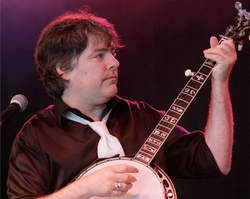by Daniel Hathaway
The tickets
Somehow, the Brooklyn-born Copland — paralleling the background of New York-born cowboy Wiliam Bonney, the subject for Lincoln Kirstein’s 1938 ballet — managed to evoke the wide open spaces and the joys and sorrows of the Wild West in music that is unmistakeably and iconically “American”. The suite is a terrific piece of orchestral choreography full of stories, scenes, moods, colors and rhythms that creates its own brilliant scenario without a dancer in sight.
Except perhaps for Guerrero, who bounded onstage, leapt to the podium and added quite a lot of kinetic energy to the dancerless ballet. He’s a conductor who seems drawn to big gestures, brilliance and flair — tendencies that sometimes lead him to push through music that needs more nuance and breathing room. Parts of Billy the Kid could have been more laid-back to good effect and climaxes more relaxed and less hard-edged. More careful attention to balances would have allowed Joela Jones’s piano bass notes to color the simultaneous strokes from the percussion. Michael Sachs’s trumpet solo was golden.
Bela Fleck’s Banjo Concerto was commissioned and premiered by Guerrero’s Nashville Symphony a year ago September. A big, rangy piece that lasts half an hour, the concerto is full of musically sophisticated and enticing ideas, only a few of which are related to each other or developed into larger stretches of music. Though Fleck’s subtly amplified banjo could carry well over the orchestra, most of the banjo’s contributions to the conversation came as interludes or cadenzas between orchestral passages. The exceptions were fascinating dialogues between banjo and solo instruments including one arresting musical chat Fleck had with contrabassoonist Jonathan Sherwin.
Bela Fleck is a master of his instrument and takes it into areas most Bluegrass musicians aren’t likely to be able to follow. His longer solos were harmonically and rhythmically complex and dazzled the ear. But taken as a whole, the concerto has its problems. Its chains of episodes — fascinating as each promises to be — begin to weary the ear as the lengthy piece winds on. The orchestration is idiosyncratic and involves a lot of unison lines and curious combinations (at one point, solo banjo plus bass clarinet, flute, trombone and contrabassoon). Transitions are sometimes awkward and movements end as though a time limit had suddenly expired.
But Fleck, who played a marvelous solo encore that veered off into title music from Beverly Hillbillies, has a wealth of fresh musical ideas in his head and should continue to pursue composing for himself and the symphony orchestra. The sound of a solo banjo fits beautifully with orchestral instruments. A shorter, more cohesive concerto would be great fun to hear.
The evening began with a brilliant, brassy overture, John Adams’s Short ride in a fast machine, something of a concerto for wood blocks and orchestra (masterfully played by the steady hands of Jacob Nissly). The finale was Gershwin’s American in Paris, perhaps not one of his most substantial symphonic works, in which Guerrero pushed tempos and dynamics to the hilt. Three saxophones added a relaxed, jazzy ambiance to a piece in which even the automobile horns seemed to be in a hurry.
Published on ClevelandClassical.com December 7, 2012
Click here for a printable version of this article.



